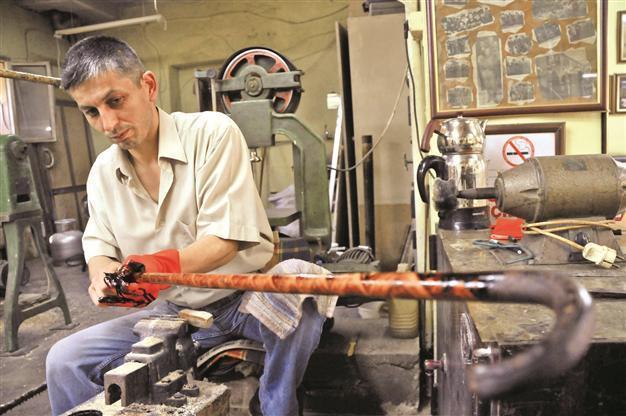Famous Devrek sticks bear unique fingerprint
ZONGULDAK- Anadolu Agency

The bodies of the famous sticks are made of cornelian cherry tree and the handles of plane tree. The motifs are created by dipping the sticks in the pitch. AA photo
Walking stick motifs, produced in the Black Sea province of Zonguldak’s Devrek district, where cornelian cherry springs are processed and turned into artworks, are unique and every single motif is different from the others.
Walking sticks that symbolize the life, regeneration and continuation of generations with the traditional snake motif reveal the handcraftsmanship of the artisans. The bodies of the sticks are made of cornelian cherry tree and the handles are made of plane tree. The knobs of the walking sticks are decorated with icons such as eagles, wolves, snakes, lions, horse heads, goat feet, panthers and birds, giving another meaning to the sticks. The decoration of the sticks is made with nitric acid and the orthopedic grips are from silver, and the craftsmen create random motifs by dipping the cornelian cherry sticks to the pitch.
Münteka Çelebi’s factory is considered to be the first to make walking sticks in Devrek using pitch. The craftsmen in the factory create unique sticks by using the same technique. None of the sticks are one hundred percent alike.
Çelebi’s daughter, who founded the first factory of walking sticks and trained many craftsmen, stated that her father died in 1994, after which her brother Rüştü ran the business. She took over the management of the factory after the death of her brother this year, and said they were trying to keep the factory running with her brother’s widow, Dilek Çelebi. “My brother, who recently passed away, was a lawyer, but he also worked as a walking sticks craftsman here. We felt the responsibility of continuing this heritage. With this aim, we have been continuing this branch of art since 1982,” she said.
Çelebi said that every product they were producing was made by handcrafts, so walking sticks therefore had an importance. There are many statesmen visiting the factory and many walking sticks are gifted to statesmen of different countries, such and the United States and Britain, she added.
Dilek Çelebi said they were trying to perpetuate the producing tradition of the factory after the death of her husband. The aim is to not let people forget about the different motifs and techniques.
‘Fingerprints’ of sticksFahrettin Sarı, the major craftsman working for the factory for 20 years, emphasized that the motifs created with pinch were the “fingerprints” of the walking sticks and added that these products were not very well known. Sarı added that not everyone could create these sticks and said people could not learn this technique outside the factory. “After the emery stage, a fabric dipped into pinch is rubbed around the stick. By this way motifs are created. A minor reflex of the hand or the style of holding the fabric changes the motifs. After this step, the sticks are varnished and the stages are completed. In conclusion, if you buy these walking sticks you own a unique stick.” said Sarı.
